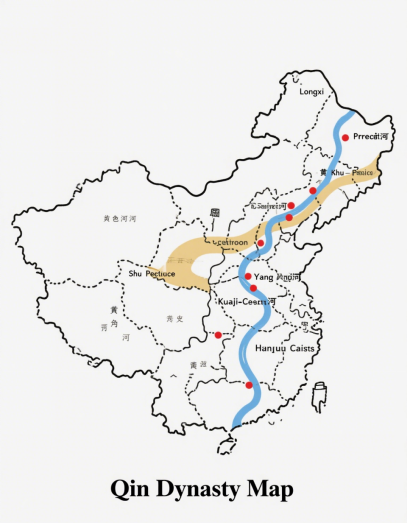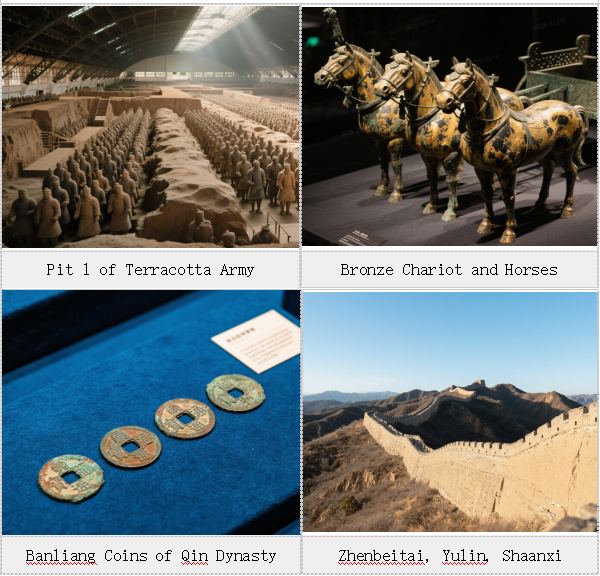Qin
The Qin Dynasty
The Qin Dynasty was the first unified, multi-ethnic, and centralized state in Chinese history. It existed from 221 BC to 207 BC. Although it only lasted for 15 years, this dynasty occupied a pivotal position in the long history of China and exerted a profound influence on the development of many subsequent dynasties. The dynasty was ruled by only two monarchs, namely Yingzheng (known as Qin Shi Huang), the first emperor in Chinese history, and his son Huhai. Eventually, the Qin Dynasty collapsed amid waves of popular uprisings.

Map of the Qin Dynasty
Political Course
In the late Warring States Period (476 BC - 221 BC), the State of Qin entered a golden age of all-round development. During Yingzheng's reign, he successively defeated the six vassal states of Han, Zhao, Wei, Yan, Chu, and Qi from 230 BC to 221 BC, putting an end to the more than 500-year-long situation of separatist wars among vassals. He established a unified centralized state and made Xianyang, in present-day Shaanxi Province, the capital.
During Yingzheng's rule, a series of effective measures were implemented, which made great contributions to the development of the country. However, in the later period of his reign, he imposed cruel oppression and exploitation on the people, arousing strong dissatisfaction among the masses. After Yingzheng's death, Huhai succeeded to the throne. Nevertheless, Huhai was incompetent and fatuous, which directly triggered the peasant uprising led by Chen Sheng and Wu Guang. Later, the leadership of the uprising fell into the hands of Xiang Yu and Liu Bang. In 207 BC, Xiang Yu's army defeated the Qin army, and Liu Bang led his troops into the capital, thus 宣告终结 the Qin Dynasty.
At the end of the Qin Dynasty in 207 BC, a war broke out between Liu Bang and Xiang Yu, known in history as the "Chu-Han Contention". This war lasted for four years and finally ended with Liu Bang's victory, who then established the Western Han Dynasty.
Administrative Measures of Qin Shi Huang

Terracotta Warriors and Horses of Qin Shi Huang's Mausoleum
To enhance national cohesion and ensure the long-term stability of the Qin Dynasty, Qin Shi Huang implemented a series of reforms in various fields such as politics, economy, military, and culture.
In politics, he established himself as the emperor of the country, monopolizing all major powers including politics, economy, and military. Both central and local administrative organs underwent systematic reorganization, and the establishment of local counties was also readjusted.
In the economic field, he unified the system of weights and measures and stipulated that the round coin with a square hole, known as the Banliang coin, should be the universal currency nationwide.
In addition, he unified the written language and designated Qinzhuan (Qin seal script) as the standard font. Meanwhile, he attached great importance to infrastructure construction, vigorously building water conservancy projects and roads. The world-famous Great Wall was built under his order. These measures greatly promoted the economic development of the Qin Dynasty.
Although Qin Shi Huang made many contributions to the country, he was also a tyrant. To suppress the people's thoughts, he burned a large number of books that he thought would influence the people's minds. What's more, in the second year of his reign, upon learning that some scholars were discussing his arrogance, he buried 460 scholars alive. In history, these two events are called "Burning Books and Burying Scholars". During this period, he also ordered the construction of luxurious palaces, the Great Wall, the famous Terracotta Warriors and Horses, and his own mausoleum. For this purpose, he imposed heavy exactions on the people, with harsh labor, high taxes, and strict laws and military service, making the people live a miserable life.

